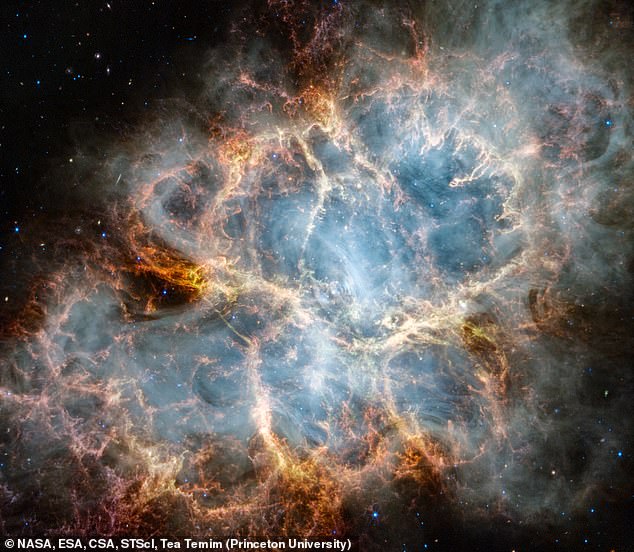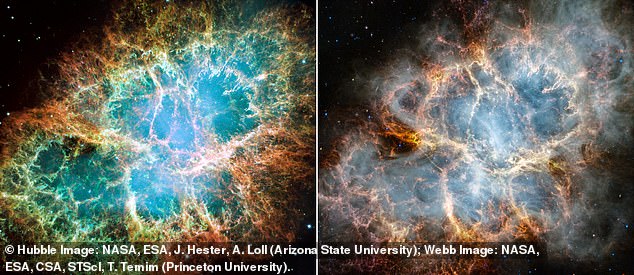The Crab Nebula as you’ve never seen it before: Stunning images by NASA’s James Webb telescope offer a new look at 1,000-year-old supernova so bright it was visible from Earth in 1054
>
- It is the remnant of a stellar explosion that lit up the sky nearly 1,000 years ago
- The Crab Nebula was visible around the world during the day for 23 days in the year 1054
It is one of the most famous nebulae known to astronomers.
But now the Crab Nebula can be seen like never before thanks to NASA’s James Webb Space Telescope.
The magnificent object is the remnant of a stellar explosion that lit up the sky nearly 1,000 years ago, and is bright enough to be seen on Earth from 6,500 light-years away.
It was visible around the world for 23 days in the year 1054.
NASA hopes this latest sighting of the glowing cosmic cloud – made possible with the help of its $10bn (£7.4bn) observatory – will help astronomers unravel its puzzling history.

Wow: It’s now possible to see the Crab Nebula like never before thanks to NASA’s James Webb Space Telescope. The magnificent object (pictured) is the remnant of a stellar explosion that lit up the sky nearly 1,000 years ago, and is bright enough to be seen on Earth from 6,500 light-years away.
“Webb’s sensitivity and spatial resolution allow us to precisely determine the composition of the ejected material, especially the iron and nickel content, which may reveal the type of explosion that produced the Crab Nebula,” said Princeton University’s T. Timmim.
He leads a team searching for answers about the origins of the Crab Nebula.
NASA said that to find the “pulsar heart” of the Crab Nebula in the image, viewers must…Trace strands that follow a circular, wave-like pattern in the middle to the bright white dot in the middle.
“Far from the core, follow the thin white streaks of radiation,” the space agency added.
“The sinuous wisps are closely packed together, illustrating the structure of the pulsar’s magnetic field, which sculpts and shapes the nebula.”
Webb is not the first telescope to capture an image of the Crab Nebula; NASA’s famous Hubble Space Telescope also did so in 2005.
However, because Webb can see in the infrared, it provides an unprecedented “clear” view of the starburst in exquisite detail.
“In the central regions, emissions from dust grains (yellow, white and green) were mapped by Webb for the first time,” NASA said.
Additional aspects of the Crab Nebula’s inner workings have become clearer and can be seen in greater detail in the infrared light captured by Webb.
“In particular, Webb highlights what is known as synchrotron radiation: an emission produced by charged particles, such as electrons, moving around magnetic field lines at relativistic speeds.
“The radiation here appears as a milky smoke-like substance throughout much of the interior of the Crab Nebula.”

Webb is not the first telescope to capture an image of the Crab Nebula; NASA’s famous Hubble Space Telescope did so in 2005 (pictured left). But because Webb can see in the infrared, it provides an unprecedented “clear” view of the starburst in exquisite detail (right).

Beautiful: The Crab Nebula (pictured) is about 6,500 light-years from Earth, is 11 light-years across, and is expanding at a speed of 930 miles per second.
The name of the supernova remnant comes from the name of astronomer William Parsons, who observed it in 1850 and produced a drawing resembling a crab.
It was first discovered in 1731, and subsequent studies suggest that its formation is consistent with a bright supernova observed by the Chinese in 1054.
Its connection to the supernova explosion SN 1054 came in the early 20th century when astronomers studied observations made by Chinese astronomers dating back to July 4, 1054.
They reported seeing a new star bright enough to see in the daytime in the same part of the sky where the Crab Nebula is found today.
It is not visible to the naked eye, but has a similar apparent size to Saturn’s moon Titan, which means it can be seen using binoculars if conditions are right.
It is about 6,500 light-years from Earth, 11 light-years across, and expanding at a speed of 930 miles per second.
There is a pulsar at the center of the nebula that rotates at a rate of 30.2 times per second, emitting a pulse of radiation from gamma rays to radio waves.
(Tags for translation)dailymail

